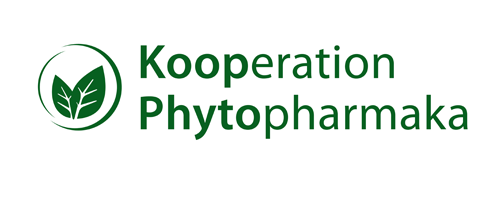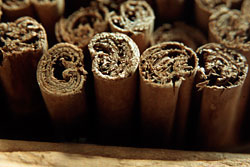Botanical name
Cinnamomum verum J. Presl (= C. ceylanicum Blume)
Family
Lauraceae
Common name
True cinnamon tree, Ceylon cinnamon tree
Information about the plant
The cinnamon tree is native to Sri Lanka (formerly Ceylon) and India and is widely cultivated in tropical regions, especially in Indonesia, Sri Lanka, the Seychelles, and Madagascar. Until 1972, Sri Lanka was called ‘Ceylon’, which is why the spice is also known as ‘Ceylon cinnamon’ and the ‘real’ cinnamon tree long bore the species epithet ceylanicum (= Ceylon cinnamon tree) - now verum (Latin ‘verum’ = true, ‘real’). It is a 6- to 12-metre-high evergreen tree; its oval leaves are leathery and are arranged opposite each other on the branches. When young, they are bright red, but later turn dark green with white veins and emit a clove-like aroma. The small, white flowers form acorn-like fruits.
Cinnamon bark is a very old spice that was already popular in ancient Egypt, Rome, and the Middle East. It is peeled from the thinner branches, which is why the cultivated trees are kept short, like basket willows, so that the proportion of stems is high.
Medicinally used parts of plants (herbal drug)
The bark (Cinnamomi cortex) is used after the cork and underlying layers have been removed. The bark is removed from the stems with knives and placed around logs. The cork layer and part of the outer bark are then removed with sharp knives. The remaining inner layer of bark, which is rich in essential oil, is rolled up. Eight to ten pieces of bark are stacked inside each other and dried in the shade. The essential oil of the cinnamon bark is also medicinally used (cinnamon oil - Cinnamomi zeylanici corticis aetheroleum), as is the essential oil of the leaves (cinnamon leaf oil - Cinnamomi zeylanici folii aetheroleum).
Constituents of the herbal drug
Cinnamon bark contains an aromatic essential oil (‘cinnamon oil’) with cinnamaldehyde as the main component; it also contains catechin tannins and caffeic acid derivatives. For coumarin content see ‘Notes’. The main component of cinnamon leaf oil is eugenol.
Quality of the drug
The quality of the following drugs or drug preparations is specified in the European Pharmacopoeia (Ph. Eur.):
- Cinnamon bark (Cinnamomi cortex)
- Cinnamon oil (Cinnamomi zeylanici corticis aetheroleum)
- Cinnamon leaf oil (Cinnamomi zeylanici folii aetheroleum)
Medical applications
Recognised medical use
The HMPC has classified cinnamon bark as a traditional herbal medicinal product (see ‘Traditional use’).
ESCOP: For dyspeptic complaints, such as mild spasmodic complaints in the gastrointestinal tract, flatulence and bloating, loss of appetite, and diarrhea.
The blood sugar-lowering effect of cinnamon bark powder or aqueous extracts of cinnamon bark remains under discussion. While animal studies on mice have demonstrated an antidiabetic effect, the data available in clinical studies with diabetic patients is not conclusive. The findings to date are insufficient to recommend its use to lower blood sugar levels in diabetics. Despite this situation, corresponding preparations are on the market but do not have medicinal status. Such preparations can be used as a dietary supplement to help manage diabetes mellitus. However, the dose of doctor-prescribed oral antidiabetics may only be reduced after consulting with the treating physician.
Traditional use
Cinnamon bark and cinnamon oil have been classified by the HMPC as traditional herbal medicinal products (Article 16a of Directive 2001/83/EC). Based upon long-standing use, cinnamon bark and cinnamon oil can be used to treat mild, spasmodic gastrointestinal complaints, including flatulence and bloating. Cinnamon bark can also be used for mild diarrhea.
Herbal drug preparations in finished dosage forms
- Crushed cinnamon bark for tea (stomach tea)
- Powdered cinnamon bark in capsules
- Alcoholic extracts (including cinnamon bark tincture) in drops and other liquids
- Cinnamon oil in liquids for ingestion and for mouth rinses
Dosage
Cinnamon bark tea for dyspeptic complaints and appetite stimulant in mixtures with other drugs: daily dose 2 to 4 g cinnamon bark.
Essential cinnamon oil: daily dose 0.02 to 0.2 g daily.
Preparation of a tea
Not commonly used, but often as a tea mixture with other drugs and as a flavor enhancer.
Notes
Cinnamon bark should not be taken in case of hypersensitivity to cinnamon, tolu or Peru balsam, or in case of stomach and intestinal ulcers.
No safety studies are available on the use of cinnamon bark during pregnancy and lactation. The use in children and adolescents under the age of 18 is not recommended due to a lack of evidence.
The Federal Institute for Risk Assessment (BfR) has updated its opinion on coumarin based on new data (Statement No. 036/2012 of the Federal Institute for Risk Assessment of 27 September 2012). Since 2011, new limit values for coumarin in ready-to-eat foods have been in place within the European Union (EU). Even when the maximum of these new EU limit values is reached, exceeding the TDI (tolerable daily intake) is only possible if large quantities of cinnamon-containing foods are consumed daily. For small children with a body weight of 15 kg, the maximum TDI value would be reached by eating 30g of cinnamon star cookies (i.e. about 6 small cookies) or 100 g of gingerbread per day. However, no limits have been set for cinnamon sticks and cinnamon powder as spices for domestic use. Assuming an average coumarin content of 3000 mg of cinnamon per kilogram of cassia cinnamon, the TDI could be exceeded by people who frequently consume a significant amount of cassia cinnamon. For an adult with a body weight of 60 kg, the TDI is reached if 2 g of cassia cinnamon are consumed per day. For an infant with a body weight of 15 kg, it would be exceeded if 0.5 g of cassia cinnamon are consumed per day. Overall exposure can be increased by other sources, such as coumarin-containing cosmetics. Consumers who frequently and regularly eat cinnamon-containing foods should be aware of this.
Side effects
Allergic skin or mucous membrane reactions can often occur caused by cinnamaldehyde, the main component of the essential oil. If cinnamon bark is taken in large quantities, it can cause palpitations, increased respiratory activity, and intestinal peristalsis accompanied by sweating. This is followed by a phase of drowsiness.
Interactions
None known.
References
Herbal drug monographs
HMPC (2011, 2021), ESCOP (2003), WHO Vol. 1
Further literature
Commentary on the European Pharmacopoeia (Cinnamon bark, No. 0387; Cinnamon oil, No. 1501; Cinnamon bark tincture, No. 1819)


